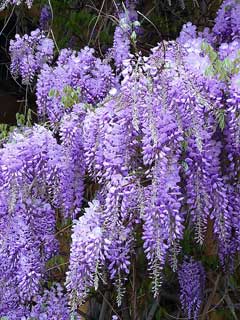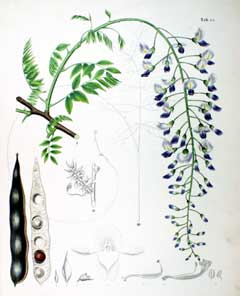 |
|
commons.wikimedia.org/wiki/User:3268zauber |
 |
| commons.wikimedia.org/wiki/File:Wisteria_sinensis_SZ44.png |
Translate this page:
Summary
Bloom Color: Blue, Lavender, Purple, White. Main Bloom Time: Early spring, Late spring, Mid spring. Form: Spreading or horizontal, Variable height, Variable spread.
Physical Characteristics

 Wisteria_sinensis is a deciduous Climber growing to 25 m (82ft) by 20 m (65ft) at a medium rate.
Wisteria_sinensis is a deciduous Climber growing to 25 m (82ft) by 20 m (65ft) at a medium rate.
See above for USDA hardiness. It is hardy to UK zone 5. It is in flower in May, and the seeds ripen from September to October. The species is hermaphrodite (has both male and female organs) and is pollinated by Insects.
It can fix Nitrogen.
Suitable for: light (sandy), medium (loamy) and heavy (clay) soils and prefers well-drained soil. Suitable pH: mildly acid and neutral soils. It cannot grow in the shade. It prefers moist soil.
UK Hardiness Map
US Hardiness Map
Synonyms
Glycine sinensis. Millettia chinensis. Rehsonia sinensis. Wisteria chinensis. Wisteria praecox
Plant Habitats
Edible Uses
Seed - cooked[105, 177, 183]. Some caution is advised, see notes on toxicity at the top of the page. Flowers - cooked. They are thoroughly washed and then boiled or made into fritters[105, 177, 179, 183]. The flowers are also cured in sugar then mixed with flour and made into a famous local delicacy called 'Teng Lo'[249]. The leaves contain allantoic acid[218]. They are used as a tea substitute[218]. The young leaves have also been eaten[249].
References More on Edible Uses
Medicinal Uses
Plants For A Future can not take any responsibility for any adverse effects from the use of plants. Always seek advice from a professional before using a plant medicinally.
The seed is diuretic[178, 218]. It is used in the treatment of heart ailments[178, 218]. One report says that the stems and flowers are also used in Chinese medicine, but gives no more information[249].
References More on Medicinal Uses
The Bookshop: Edible Plant Books
Our Latest books on Perennial Plants For Food Forests and Permaculture Gardens in paperback or digital formats.

Edible Tropical Plants
Food Forest Plants for Hotter Conditions: 250+ Plants For Tropical Food Forests & Permaculture Gardens.
More

Edible Temperate Plants
Plants for Your Food Forest: 500 Plants for Temperate Food Forests & Permaculture Gardens.
More

More Books
PFAF have eight books available in paperback and digital formats. Browse the shop for more information.
Shop Now
Other Uses
A fibre from the stems can be used to make paper, the fibre is about 1.3 - 3.7mm long[189]. Stems are harvested in the summer, the leaves removed and the stems steamed until the fibre can be stripped. The fibres are cooked for 2 hours with lye and then put in a ball mill for 3 hours. The paper is a buff colour[189]. Nitrogen Fixer.
Special Uses
References More on Other Uses
Cultivation details
Landscape Uses:Arbor, Espalier, Pollard, Standard. Prefers a good loamy soil in a sunny south or south-west facing position, sheltered from cold winds and from early morning sun on frosty mornings[11, 200]. Succeeds in partial shade. Plants can become chlorotic on alkaline soils[200]. A soil that is too rich results in excessive foliage at the expense of flowering[200]. Hardy to about -15°c[184, 200]. Plants can take a few years to settle down after planting out[219]. Too much shade or too rich a soil are normally the culprits, some form of root restriction can be beneficial[219]. There are several named forms selected for their ornamental value[188]. Sparrows and other birds frequently eat the young buds of this plant and this is the commonest cause of poor flowering on established plants[184]. Plants sometimes have a second season of flowering in August[219]. The plants flower mainly on short spurs so, if removing unwanted side-branches, it is best to cut them back to 2 - 3 leaves rather than removing them completely since this will encourage the formation of flowering spurs[249]. Any drastic pruning is best carried out in the spring, immediately after flowering[249]. Plants are very tolerant of even the most drastic pruning and will re-grow even if cut right back to the base[249]. A climbing plant supporting itself by twining around other plants, the shoots twine in an anticlockwise direction[182]. Very tolerant of pruning, plants can regenerate from old wood[202]. Plants in this genus are notably susceptible to honey fungus[200]. Closely related to W. floribunda[126]. This species has a symbiotic relationship with certain soil bacteria, these bacteria form nodules on the roots and fix atmospheric nitrogen. Some of this nitrogen is utilized by the growing plant but some can also be used by other plants growing nearby[200]. The plants also form a symbiotic relationship with a mycorrhizal fungus which makes more water, phosphorus and other minerals available to the plants[249]. Special Features:Not North American native, Invasive, Naturalizing, All or parts of this plant are poisonous, Attracts butterflies, Fragrant flowers, Blooms are very showy.
References Carbon Farming Information and Carbon Sequestration Information
Temperature Converter
Type a value in the Celsius field to convert the value to Fahrenheit:
Fahrenheit:
The PFAF Bookshop
Plants For A Future have a number of books available in paperback and digital form. Book titles include Edible Plants, Edible Perennials, Edible Trees,Edible Shrubs, Woodland Gardening, and Temperate Food Forest Plants. Our new book is Food Forest Plants For Hotter Conditions (Tropical and Sub-Tropical).
Shop Now
Plant Propagation
The seed does not exhibit any dormancy habits. It can be sown as soon as it is ripe in a cold frame and should germinate in the spring. Pre-soak stored seed for 24 hours in warm water and then sow in a greenhouse in early spring. The seed can also be sown in an outdoor seedbed in late spring[126]. Germination should take place in the first spring, though it can sometimes be delayed for another 12 months. Prick out the seedlings into individual pots when they are large enough to handle and grow them on in a cold frame for their first winter. Plant them out in late spring or early summer. Plants are very slow from seed and can take up to 20 years to come into flower[200]. Basal cuttings of side-shoots in early to mid summer in a frame[200]. Take the cuttings as soon as the new growth has hardened sufficiently, each cutting should have 2 - 3 leaves[249]. It can also help to remove a shallow slice of bark from the bottom 15mm of the cutting to expose extra cambium, since this will encourage more callusing and better rooting[249]. When kept in a mist frame with a bottom heat of 27 - 30°c, they will root within 4 weeks and produce well-established plants by the autumn[249]. Layering in spring. Simply lay any convenient long shoot along the ground and cover it with a shallow layer of soil. The shoot will readily produce roots at intervals along the stem. When these are well formed, the shoot can be divided up into a number of plants. These should be potted up and kept in a lightly shaded position in a greenhouse until well established and can then be planted out as required. Division of suckers in the winter[249]. If growing named varieties, it is of course necessary to ensure they are growing on their own roots if the suckers are to be true to type[249].
Other Names
If available other names are mentioned here
Native Range
TEMPERATE ASIA: China (Henan Sheng, Hebei Sheng, Hubei Sheng, Guizhou Sheng, Shaanxi Sheng, Yunnan Sheng, Guangxi Zhuangzu Zizhiqu)
Weed Potential
Right plant wrong place. We are currently updating this section.
Please note that a plant may be invasive in one area but may not in your area so it’s worth checking.
Conservation Status
IUCN Red List of Threatened Plants Status :

Growth: S = slow M = medium F = fast. Soil: L = light (sandy) M = medium H = heavy (clay). pH: A = acid N = neutral B = basic (alkaline). Shade: F = full shade S = semi-shade N = no shade. Moisture: D = dry M = Moist We = wet Wa = water.
Expert comment
Author
(Sims.)DC.
Botanical References
11200266
Links / References
For a list of references used on this page please go here
Readers comment